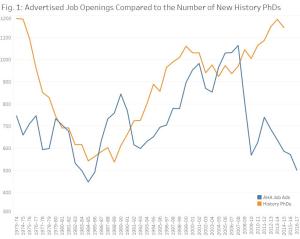 This week, the American Historical Association previewed a forthcoming report on the number of full-time history jobs. The post is entitled “Another Tough Year for the Academic Job Market in History”—which is a bit misleading, since it documents the continuation of a decade-long collapse. In the last hiring year (2016-2017), employers advertised only 289 tenure-track faculty positions and 212 other full-time jobs in the AHA Career Center. During that same year, to judge by the recent past, American universities probably granted more than 1,000 new doctorates in history.
This week, the American Historical Association previewed a forthcoming report on the number of full-time history jobs. The post is entitled “Another Tough Year for the Academic Job Market in History”—which is a bit misleading, since it documents the continuation of a decade-long collapse. In the last hiring year (2016-2017), employers advertised only 289 tenure-track faculty positions and 212 other full-time jobs in the AHA Career Center. During that same year, to judge by the recent past, American universities probably granted more than 1,000 new doctorates in history.
Tag Archives: careers
Guest Post: Why and How You Should Build a Web Presence
Today’s guest post is by Lindsay M. Chervinsky. She is a postdoctoral fellow at the Center for Presidential History at Southern Methodist University. She received her Ph.D. from the University of California, Davis and is completing her manuscript, “The President’s Cabinet: George Washington and the Creation of an American Institution.”

As the new school year starts, many departments are offering seminars for their graduate students on skills and approaches to find a job in this difficult market. Editorials on ChronicleVitae and the American Historical Association mission to document where historians work demonstrate that the history community is beginning to welcome “non-traditional” employment opportunities. While these efforts represent a great first step to introducing students to jobs in editing, public history, and teaching, I would argue that there should be a broader conversation about learning to create a public voice and building a web presence.
Where Historians Work: Q&A with Emily Swafford of the AHA
 Welcome to the first installment of our “Where Historians Work: The View from Early America” series. Today, The Junto features a Q&A between Katy Lasdow and Dr. Emily Swafford, Manager of Academic Affairs for the American Historical Association in Washington, D.C.[1] Emily shares her experiences seeking out varied career options after graduate school. She also provides AHA resources for readers who wish to become more involved in the conversation about career diversity, whether as part of their own job searches, or within their graduate history departments.
Welcome to the first installment of our “Where Historians Work: The View from Early America” series. Today, The Junto features a Q&A between Katy Lasdow and Dr. Emily Swafford, Manager of Academic Affairs for the American Historical Association in Washington, D.C.[1] Emily shares her experiences seeking out varied career options after graduate school. She also provides AHA resources for readers who wish to become more involved in the conversation about career diversity, whether as part of their own job searches, or within their graduate history departments.
Continue reading